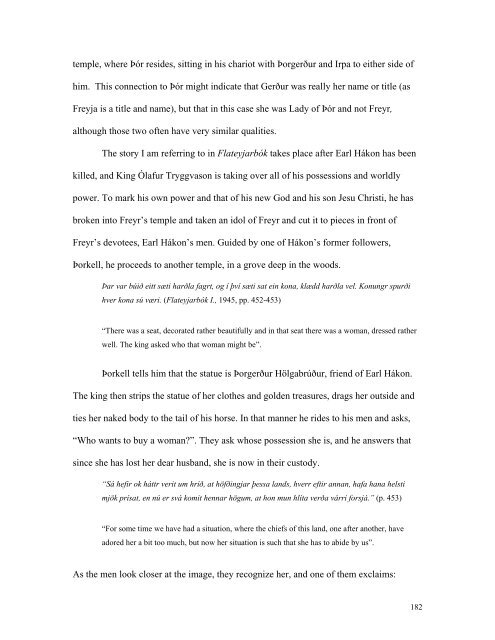You also want an ePaper? Increase the reach of your titles
YUMPU automatically turns print PDFs into web optimized ePapers that Google loves.
temple, where Þór resides, sitting in his chariot with Þorgerður <strong>and</strong> Irpa to either side <strong>of</strong><br />
him. This connection to Þór might indicate that Gerður was really her name or title (as<br />
Freyja is a title <strong>and</strong> name), but that in this case she was Lady <strong>of</strong> Þór <strong>and</strong> not Freyr,<br />
although those two <strong>of</strong>ten have very similar qualities.<br />
<strong>The</strong> story I am referring to in Flateyjarbók takes place after Earl Hákon has been<br />
killed, <strong>and</strong> King Ólafur Tryggvason is taking over all <strong>of</strong> his possessions <strong>and</strong> worldly<br />
power. To mark his own power <strong>and</strong> that <strong>of</strong> his new God <strong>and</strong> his son Jesu Christi, he has<br />
broken into Freyr’s temple <strong>and</strong> taken an idol <strong>of</strong> Freyr <strong>and</strong> cut it to pieces in front <strong>of</strong><br />
Freyr’s devotees, Earl Hákon’s men. Guided by one <strong>of</strong> Hákon’s former followers,<br />
Þorkell, he proceeds to another temple, in a grove deep in the woods.<br />
Þar var búið eitt sæti harðla fagrt, og í því sæti sat ein kona, klædd harðla vel. Konungr spurði<br />
hver kona sú væri. (Flateyjarbók I., 1945, pp. 452-453)<br />
“<strong>The</strong>re was a seat, decorated rather beautifully <strong>and</strong> in that seat there was a woman, dressed rather<br />
well. <strong>The</strong> king asked who that woman might be”.<br />
Þorkell tells him that the statue is Þorgerður Hölgabrúður, friend <strong>of</strong> Earl Hákon.<br />
<strong>The</strong> king then strips the statue <strong>of</strong> her clothes <strong>and</strong> golden treasures, drags her outside <strong>and</strong><br />
ties her naked body to the tail <strong>of</strong> his horse. In that manner he rides to his men <strong>and</strong> asks,<br />
“Who wants to buy a woman?”. <strong>The</strong>y ask whose possession she is, <strong>and</strong> he answers that<br />
since she has lost her dear husb<strong>and</strong>, she is now in their custody.<br />
“Sá hefir ok háttr verit um hríð, at höfðingjar þessa l<strong>and</strong>s, hverr eftir annan, hafa hana helsti<br />
mjök prísat, en nú er svá komit hennar högum, at hon mun hlíta verða várri forsjá.” (p. 453)<br />
“For some time we have had a situation, where the chiefs <strong>of</strong> this l<strong>and</strong>, one after another, have<br />
adored her a bit too much, but now her situation is such that she has to abide by us”.<br />
As the men look closer at the image, they recognize her, <strong>and</strong> one <strong>of</strong> them exclaims:<br />
182


